Capsule Review: EVGA GeForce GTX 780 Superclocked ACX
by Ryan Smith on September 22, 2013 12:00 PM ESTPower, Temperature, & Noise
Having seen the gaming performance of the card, let’s move on to power, temperature, and noise to get a better look at the performance characteristics of EVGA’s new ACX cooler. This will also give us a chance to evaluate the costs of EVGA’s factory overclock with respect to power consumption.
| GeForce GTX 780 Voltages | ||||
| 780SC ACX Max Boost | Ref GTX 780 Max Boost | 780SC ACX Idle | ||
| 1.1625v | 1.1625v | 0.862v | ||
Briefly, since the 780SC ACX is a factory overclocked semi-custom card, other than clockspeeds there haven’t been any further board-level modifications by EVGA. The max voltage is still 1.1625v, with the 780SC ACX simply running at higher clockspeeds anywhere along the voltage curve.
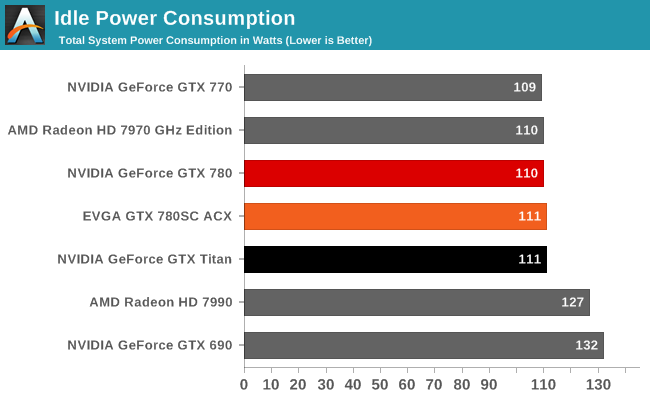
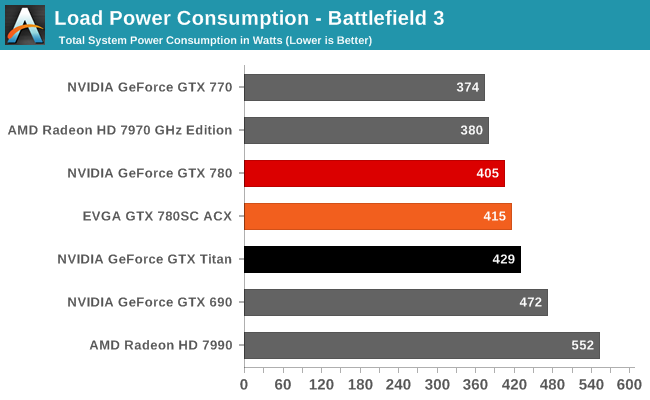
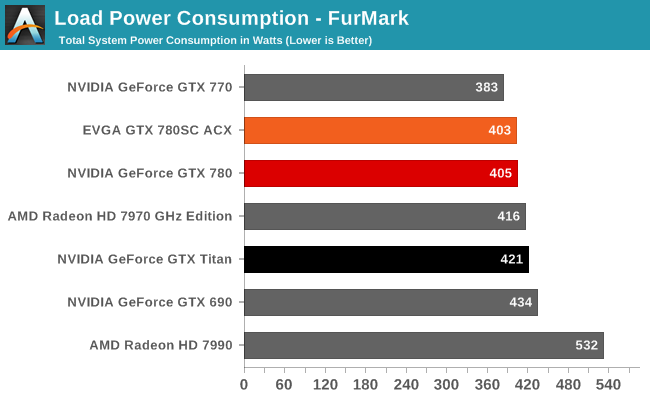
With voltages going unchanged, power consumption is similarly unfazed. Load power consumption under BF3 increases by just 10W at the wall to 415W, and even then some portion of that is due to the increased CPU load to generate more frames. Looking at FurMark and its much more GPU-focused load, the 780SC ACX does even better at 2W less.
Given that the official TDP for GTX 780 is 250W, these small shifts in power consumption end up being just short of trivial. There is a minor power consumption increase due to the overclock, but with such a small increase the performance may as well be free. Especially in light of the fact that the 780SC ACX’s power consumption is still around 15W less than that of GTX Titan, owing in part to binning, and in part to the fact that the card has half as many GDDR5 memory chips as Titan.
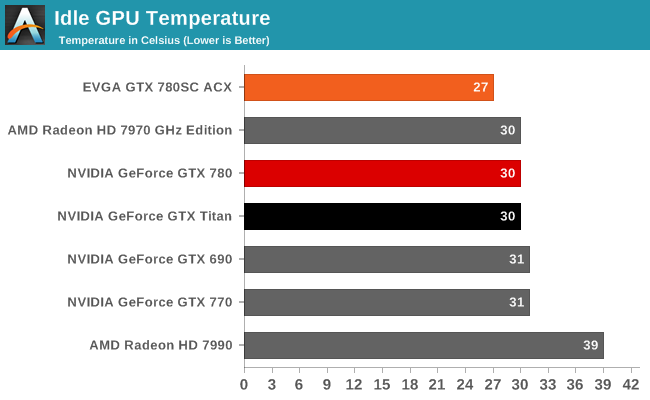
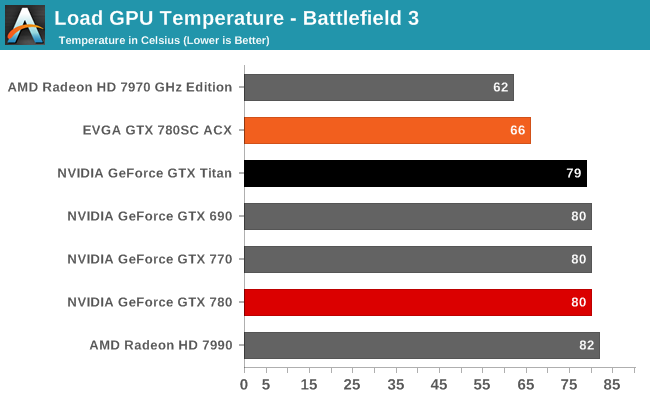

Moving on to temperatures we finally get to see EVGA’s ACX cooler in action. We don’t have any other semi-custom GTX 780s on hand so we can’t make any proper comparisons to other open air coolers, but with that said the numbers we’re seeing here are consistent with a good open air cooler. Compared to the reference GTX 780 and its blower, the ACX cooler proves capable of pushing the card under 30C at idle, and meanwhile load temperatures are an impressive 15C below the reference GTX 780. In fact of all of the high-end cards in our lineup, it’s the coolest under FurMark at 69C.
Such strong cooling performnace delivers a side benefit for the 780SC ACX in the form of keeping it away from the GTX 780’s stock thermal throttle point of 80C. As the card never reaches 80C it never throttles based on thermal conditions, allowing it to hit higher clockspeed bins more often, thereby slightly boosting performance. Ultimately it’s still equally power constrained – which typically goes hand in hand with thermal constraints – but in the right scenarios it’s good for an extra bin or two.
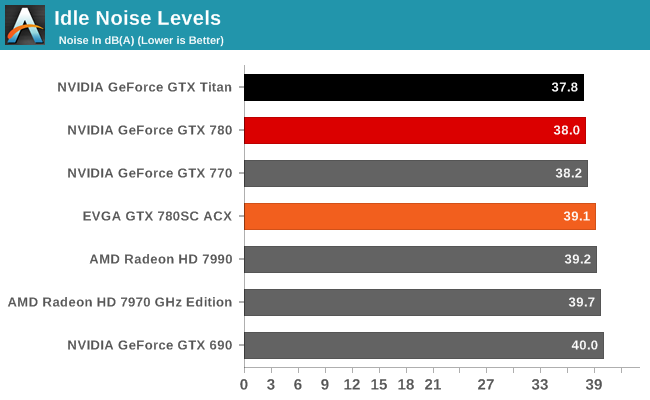
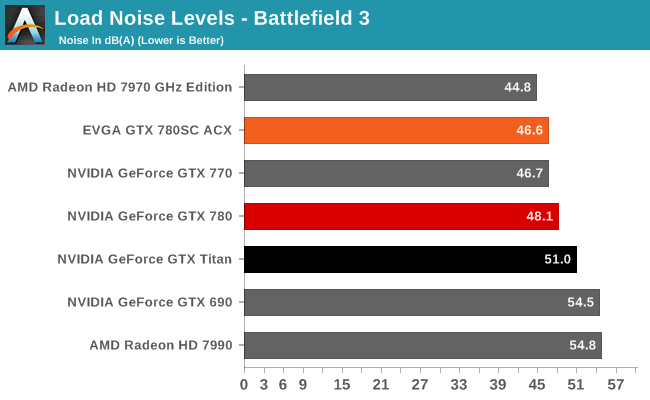
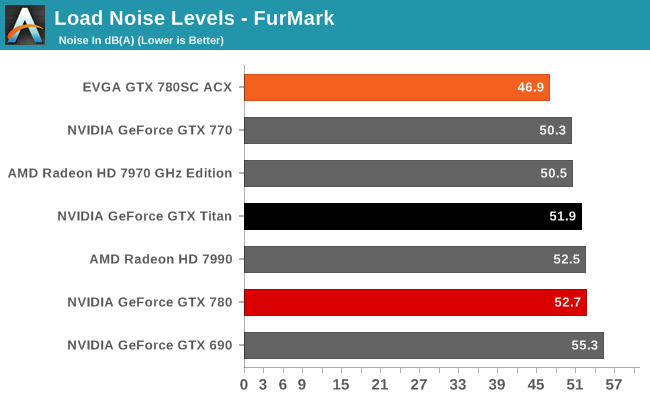
Finally let’s take a look at noise. The GTX 780’s reference cooler was in part tuned for very good idle noise levels, so it’s not something that’s easily surpassed. In this case the 780SC ACX ends up being just over 1dB louder, an unsurprising outcome given the competition and the fact that twin fan open air coolers as a whole typically fall into this scenario.
Meanwhile load noise looks quite good. Based on our data it looks like EVGA has tuned the 780SC ACX to slightly favor temperatures over noise, but even so they’re still easily beating the reference GTX 780. This ends up being a 1.5dB advantage under BF3, while the more punishing (and ultimately worst case scenario) FurMark sees the card beat the reference GTX 780 by just under 6dB. Or compared to Titan the advantages are even greater, with a 4.4dB advantage to the 780SC under BF3 and a similar advantage under FurMark. In the end, unlike the 780/Titan reference cooler, the ACX cooler doesn’t need to significantly increase its fan speeds to handle the extra load presented by FurMark, which is why we see noise levels almost identical between that and BF3.
Ultimately EVGA’s ACX cooler performs very well under load, which is no less than what we’d expect given the design and EVGA’s expertise in the matter. Like other open air coolers, the ACX cooler provides lower temperatures and lower noise levels than the equivalent reference blower, delivering Titan-like performance for under 47dB. Of course it goes without saying that this is a tradeoff; an open air cooler pushes more of the cooling load onto the chassis itself, so while the ACX cooler is highly effective in a large, airy case like our Spedo, it’s generally not the best choice for small and/or low airflow scenarios, those scenarios being where the reference blower best excels.










40 Comments
View All Comments
cactusdog - Sunday, September 22, 2013 - link
Im not sure its a good time to buy a card like this, with the R9 290X coming in a couple of weeks.CiccioB - Monday, September 23, 2013 - link
Because you buy top of the performance with stable drivers and assured quality.If one is interested in these kind of gfx board would have just to wait for AMD to launch their new series for the price to lower a bit.
For someone good solid drivers available yesterday is something that is more valuable then 5 frames more tomorrow (and support for new games next month).
tackle70 - Monday, September 23, 2013 - link
Thanks for the review!I picked up a pair of these at launch to replace a pair of lightning 7970s... couldn't be happier with them. Ridiculously fast, cool, and quiet.
Now hopefully their price will drop by $100 or so as AMD's new cards come out and can finally offer up some competition.
bds71 - Monday, September 23, 2013 - link
it amazes me that reviewers still try to make titan out as a consumer gaming card. it's claim-to-fame is its number crunching ability (particularly FP). it's a monster!! it's not a gaming card, nor, i suspect, was it ever intended to be. i bought a 690 when they were released (OK, maybe it took me a few months to actually FIND one, but you know what i mean)....for the same price, it utterly defeats the titan to the point of rediculousness. i calculated my own numbers based on this review as well. on average, the stock 780 is 72% (performance) of the 690 for 65% of the cost - more what one would expect with their differences in arcitecture (104 vs 110). in addition to this, i also fold/crunch. as a cruncher, the 690 is STILL better than titan due to its two cores!! if any of you bought a titan (for gaming, or crunching) i just gotta ask: why? the 690 is 10-15% better in both respects. sure, i can see getting a 780 vs 690: $350 is nothing to sneeze at, and it is slightly better (7%) performance/cost ratio. but, titan? fail. (unless your one of those very few/limited folks who actually do use it for its FP operation)erple2 - Tuesday, September 24, 2013 - link
Interesting. According to anandtech's own bench, the titan obliterates the 690 in compute tasks. Which is really what I expect given the 680's relatively weak compute units. So I'm not quite sure which compute benchmarks you're running to demonstrate the superiority of the 690 over the Titan...bds71 - Monday, September 23, 2013 - link
and before anyone thinks to comment about OCing the 780 vs 690 (this being an article about an OC'ed 780) they both have about the same OCing potential - both can reach 1200 MHz without too much effort so i would say OCing is a wash between the two. that's why i did not use the numbers from the OCed version in this review (i used numbers from the stock)tackle70 - Monday, September 23, 2013 - link
OCing is absolutely not a wash between the two on average... 780 is quite superior *on average*http://hwbot.org/hardware/videocard/geforce_gtx_69...
http://hwbot.org/hardware/videocard/geforce_gtx_78...
JPForums - Monday, September 23, 2013 - link
What's the point of all the ventilation in the back of the card when you set the fins vertically. Airflow won't directly exhaust out the back with a wall of fins blocking it. Half the heated air is directed at the motherboard. It only really serves to let noise out. The power side of the card doesn't make as much of a difference, but the bracket side of the card should have horizontal fins. Other than that, I've always like EVGA board design and customer support. It is good that they've been trying to expand their cooler designs for the 600 and 700 series. I hope they keep trying to improve.alkhanzi - Monday, September 23, 2013 - link
The 7990 hugely beats both the Titan and EVGA 780 in each and every of the benchmarks, and costs the same(+ the game bundle).tackle70 - Monday, September 23, 2013 - link
The 7990 is, on average, a whopping 4% faster than this card at 1920x1080, and just 14% faster at 25601600...Given the heat/coil whine/driver issues that the 7990 has, I'll take the 780 ten times out of ten.